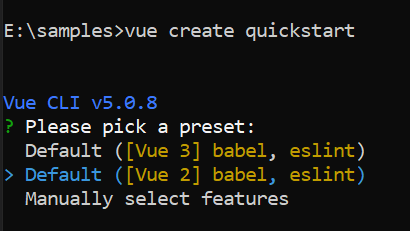Getting Started with the Vue Bullet chart Component in Vue 2
25 Apr 202510 minutes to read
This article provides a step-by-step guide for setting up a Vue 2 project using Vue-CLI and integrating the Syncfusion® Vue Bullet chart component
Prerequisites
System requirements for Syncfusion® Vue UI components
Dependencies
Below is the list of minimum dependencies required to use the Bullet Chart component.
|-- @syncfusion/ej2-vue-charts
|-- @syncfusion/ej2-base
|-- @syncfusion/ej2-data
|-- @syncfusion/ej2-pdf-export
|-- @syncfusion/ej2-file-utils
|-- @syncfusion/ej2-compression
|-- @syncfusion/ej2-charts
|-- @syncfusion/ej2-vue-base
|-- @syncfusion/ej2-svg-baseSetting up the Vue 2 project
To generate a Vue 2 project using Vue-CLI, use the vue create command. Follow these steps to install Vue CLI and create a new project:
npm install -g @vue/cli
vue create quickstart
cd quickstart
npm run serveor
yarn global add @vue/cli
vue create quickstart
cd quickstart
yarn run serveWhen creating a new project, choose the option Default ([Vue 2] babel, eslint) from the menu.

Once the quickstart project is set up with default settings, proceed to add Syncfusion® components to the project.
Add Syncfusion® Vue packages
Syncfusion® packages are available at npmjs.com. To use Vue components, install the required npm package.
This article uses the Vue Bullet chart component as an example. Install the @syncfusion/ej2-vue-charts package by running the following command:
npm install @syncfusion/ej2-vue-charts --saveor
yarn add @syncfusion/ej2-vue-chartsThe –save will instruct NPM to include the Bullet Chart package inside of the
dependenciessection of thepackage.json.
Add Syncfusion® Vue component
Follow the below steps to add the Vue Bullet chart component using:
1. First, import and register the Bullet chart component in the script section of the src/App.vue file.
<script>
import { BulletChartComponent } from '@syncfusion/ej2-vue-charts';
export default {
components: {
'ejs-bulletchart': BulletChartComponent
}
}
</script>2. In the template section, define the Bullet chart component.
<template>
<div>
<ejs-bulletchart id="bulletChart"> </ejs-bulletchart>
</div>
</template>Here is the summarized code for the above steps in the src/App.vue file:
<template>
<div>
<ejs-bulletchart id="bulletChart"> </ejs-bulletchart>
</div>
</template>
<script>
import { BulletChartComponent } from '@syncfusion/ej2-vue-charts';
export default {
name: "App",
components: {
'ejs-bulletchart': BulletChartComponent
},
data() {
return {
}
}
}
</script>Run the project
To run the project, use the following command:
npm run serveor
yarn run serveModule Injection
Bullet Chart component are segregated into individual feature-wise modules. In order to use a particular feature, you need to inject its feature module using provide method. In the current application,we are going to use tooltip feature of the Bullet Chart.
-
BulletTooltip- Inject this provider to use tooltip feature.
These modules should be injected to the provide method as follows,
import { BulletChartComponent, BulletTooltip } from "@syncfusion/ej2-vue-charts";
export default {
components: {
'ejs-bulletchart': BulletChartComponent
},
provide: {
bulletChart: [BulletTooltip]
}
};BulletChart With Data
This section explains how to plot local data to the Bullet Chart.
let data: any[] = [
{ value: 100, target: 80 },
{ value: 200, target: 180 },
{ value: 300, target: 280 },
{ value: 400, target: 380 },
{ value: 500, target: 480 },
];Now assign the local data to dataSource property. value and target values should be mapped with valueField and targetField respectively.
<template>
<div>
<ejs-bulletchart id="bulletChart" :dataSource="data" valueField="value" targetField="target" height="300"
:minimum="minimum" :maximum="maximum" :interval="interval"> </ejs-bulletchart>
</div>
</template>
<script>
import { BulletChartComponent } from '@syncfusion/ej2-vue-charts';
export default {
name: "App",
components: {
'ejs-bulletchart': BulletChartComponent
},
data() {
return {
data: [
{ value: 100, target: 80 },
{ value: 200, target: 180 },
{ value: 300, target: 280 },
{ value: 400, target: 380 },
{ value: 500, target: 480 },
],
minimum: 0, maximum: 500, interval: 50
}
}
}
</script>Add Bullet Chart Title
You can add a title using title property to the Bullet Chart to provide quick
information to the user about the data plotted in the Bullet Chart.
<template>
<div>
<ejs-bulletchart id="bulletChart"
:dataSource="data"
valueField="value"
targetField="target"
:minimum="minimum"
:maximum="maximum"
:interval="interval"
title="Revenue"
> </ejs-bulletchart>
</div>
</template>
<script>
import { BulletChartComponent } from '@syncfusion/ej2-vue-charts';
export default {
name: "App",
components: {
'ejs-bulletchart': BulletChartComponent
},
data () {
return {
data: [{ value: 270, target: 250 }],
minimum: 0, maximum: 300, interval: 50
}
}
}
</script>Ranges
You can add a range using e-bullet-range of the e-bullet-range-collection.
<template>
<div>
<ejs-bulletchart id="bulletChart" :dataSource="data" valueField="value" targetField="target" :minimum="minimum"
:maximum="maximum" :interval="interval" title="Revenue">
<e-bullet-range-collection>
<e-bullet-range end="100" color="red"></e-bullet-range>
<e-bullet-range end="200" color="blue"></e-bullet-range>
<e-bullet-range end="300" color="green"></e-bullet-range>
</e-bullet-range-collection>
</ejs-bulletchart>
</div>
</template>
<script>
import { BulletChartComponent, BulletRangeCollectionDirective, BulletRangeDirective } from '@syncfusion/ej2-vue-charts';
export default {
name: "App",
components: {
'ejs-bulletchart': BulletChartComponent,
'e-bullet-range-collection': BulletRangeCollectionDirective,
'e-bullet-range': BulletRangeDirective
},
data() {
return {
data: [{ value: 270, target: 250 }],
minimum: 0, maximum: 300, interval: 50
}
}
}
</script>Tooltip
You can use tooltip for the Bullet Chart by setting the enable property to true in tooltip object and by injecting the BulletTooltip module using provide method.
<template>
<div>
<ejs-bulletchart id="bulletChart" :dataSource="data" valueField="value" targetField="target" :minimum="minimum"
:maximum="maximum" :interval="interval" title="Revenue" :tooltip="tooltip"> </ejs-bulletchart>
</div>
</template>
<script>
import { BulletChartComponent, BulletTooltip } from '@syncfusion/ej2-vue-charts';
export default {
name: "App",
components: {
'ejs-bulletchart': BulletChartComponent
},
data() {
return {
data: [{ value: 270, target: 250 }],
minimum: 0, maximum: 300, interval: 50,
tooltip: { enable: true }
}
},
provide: {
bulletChart: [BulletTooltip]
}
}
</script>